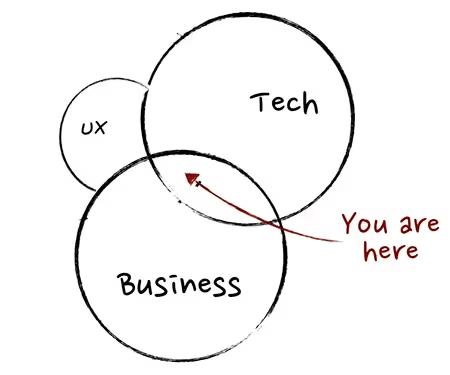15 Product Management Books for Learning User Experience

You are probably familiar with Martin Eriksson’s oft-shared Venn diagram, which shows Product Management at the intersection of Business, Technology, and User Experience (UX).Figure A: Martin Eriksson’s View of a PM:

Figure B: Your Current Reality as a PM:

The original (Figure A) is a useful representation of Product Management. In reality, many Product Managers have a nice seat between business and technology (We’ve made the case in prior articles that both technical skills and non-technical skills are equally as important for PMs)As for UX, the average PM’s Venn diagram looks a lot more like the second (Figure B), with the value and skill of UX either being poorly understood, taken for granted, or outsourced to the UX design and research teams. The list of books in this post will help you bridge that gap.
Why UX and What Is UX, Really?
UX peeks its head into all parts of Product Management, from data-driven design and user experience journey decisions to best practices for conducting user interviews and developing an eye for design or prototyping. A good Product Manager will want to move from Figure B to Figure A.UX is an umbrella term — the following are some of its main disciplines, as listed by Daniel Elizalde in his Tech Product Management blog:
- Information Architecture (IA): Data models and how data is organized in a product
- Interaction Design (IX): UX/UI Design as you traditionally think of it. IX organizes how data models from IA are interacted with through user interfaces, interactions, navigations and more.
- Visual Design (VD): Making things look attractive (there’s more to it, but that’s the gist).
- Design Research: Data-driven design (no, not an oxymoron). Case in point: A designer hands you a design. How do you know it is the best design? UX design based on good user research using quantitative and qualitative techniques is what PMs should be asking for or doing themselves.
- Usability Testing: Once you have a interactive mockup, prototype or beta of your product, usability testing is a methodology of observing users as they use the product and drawing insights on potential improvements, bugs, or flaws in the product. This includes A/B testing, usability interviews, and more.
Sounds like a lot? Never fear, the following list of books (and some bonus material) will help you navigate the world of UX, from the canonical user experience and product design concepts to data-driven user experience research and more.
15 Product Management Books for Building UX Skills

General Design
1. The Design of Everyday Things by Don Norman
The canonical piece on product design and a great place to start, especially for those new to UX and design. Don Norman’s book focuses on the design piece of UX, keeping a user-centered view. Try not to think about the great and terrible designs of things you use everyday after reading this book.
2. Emotional Design: Why We Love (or Hate) Everyday Things by Don Norman
Don Norman’s follow-up to The Design of Everyday Things, focusing on the emotional connections people have with design and products. Product Managers understand the importance of design, but do not always take into account the emotional reactions their products provoke. Emotional Design will reinforce how to keep users’ emotional connections in the forefront of your mind when building products.
UX Design
3. Don’t Make Me Think (Revisited) by Steve Krug
Originally published in 2000, Steve Krug’s cornerstone book in user experience and user interface design is updated for the modern era. Any good Product Manager should read this book for the fundamentals in thinking user-first while designing their products.
4. Smashing UX Design: Foundations for Designing Online User Experiences by Jesmond Allen and James Chudley
A great introduction to UX design, Jesmond Allen’s book covers user research, interaction design and visual design. This is a great primer for Product Managers with a lot of “how-to” guides and shows some of the deliverables you will expect from your UX team.
5. Mobile Design Pattern Gallery: UI Patterns for Smartphone Apps by Theresa Neil
If you are building mobile apps or responsive websites, understanding UI patterns for mobile is imperative. This book will build your fundamentals in UI patterns and develop your eye for good UI design.
Quantifying Design With Data

6. Measuring the User Experience: Collecting, Analyzing, and Presenting Usability Metrics by Thomas Tullis and William Albert
Thomas Tullis’ book will help you understand the metrics you need, how to collect them, and how to present them. From desired user behaviors to site performance, Measuring hte User Experience has you covered.
7. Quantifying the User Experience: Practical Statistics for User Research by Jeff Sauro and James R. Lewis
Learn to use numbers to measure UX and set performance measures for your product.
User Research: User Interviews, Usability Testing, and More
8. Handbook of Usability Testing: How to Plan, Design, and Conduct Effective Tests by Jeffrey Rubin
A very handy step-by-step guide for user research and usability testing,this is a digestible book you can refer back to when you plan and conduct tests and surveys.
9. Validating Product Ideas: Through Lean User Research by Tomer Sharon
Learn how to know what your users are thinking and how to use user research to build the best possible product.
UX Processes
10. Lean UX: Applying Lean Principles to Improve User Experience by Jeff Gothelf
Lean UX applies the same Lean concepts as The Lean Startup to the UX process, letting your team focus on the experience being designed, instead of deliverables. Learn how to rapidly experiment with design ideas, validate them with real users, and continually adjust your design based on what you learn.
11. Sprint: How to Solve Big Problems and Test New Ideas in Just Five Days by Jake Knapp
The Google Ventures Design Sprint is a fantastic methodology I have personally used with my cross-functional product teams. Developed by Google Ventures, the Design Sprint uses cross-functional teams, effective ideation, lean principles, and testing with real users to quickly test and iterate on design concepts before development. This step-by-step guide is all you need to get going.
12. UX for Lean Startups by Laura Klein
X’s book teaches Product Managers how to listen to customers throughout the product’s lifecycle, understand why you should design a test before you design a product, find the tools that are critical to designing your product, and learn how a Minimum Viable Product affects UX decisions. The book includes a discussion on A/B testing with good UX practices and speeding up product development without sacrificing quality.
UX Beyond Your Product
13. Pervasive Information Architecture: Designing Cross-Channel User Experiences by Andrea Resmini
User experience doesn’t stop at the user’s screen, and neither does a PM’s job. This book shows how interaction design depends on user behavior both online and offline and will help you explore user interaction opportunities in any environment.
14. Designing for Interaction: Creating Innovative Applications and Devices by Dan Saffer
A fresh take on the world of interaction design taking into account modern challenges in design through anecdotes and interviews with interaction design founders and luminaries.
Habit-Forming User Experiences
15. Hooked: How to Build Habit-Forming Products by Nir Eyal
Using excellent, practical examples, Nir Eyal’s breakthrough book sets out in detail how habit-forming products are created. You can look to this book to improve your UX understanding and increase user engagement with your product. It’s a great, digestible, classic book that is - even if you’re familiar with it - well-worth a repeat read with an eye toward UX
In Sum
Reading these books should make any Product Manager well-rounded and better able to make effective UX decisions. There is more to becoming learned in US than reading books, of course — Look for sites and magazines that highlight design best practices for the platforms important to your product, such as Smashing Magazine’s Web Design Elements: Examples And Best Practices and UXDesign.cc. You should also research the tools that you can use for UX research, design collaboration, and user studies, such as InVision, UserTesting and Photoshop. Understanding how Product Managers can work effectively with UX teams is another soft-skill that will help you round out your UX skills.Above all else, remember: UX teams were created to fill the gaps left by Product Management, but they are not a replacement. UX is one of the most exciting parts of building products — the stories in the books above are usually compelling and relatable and the ideas and suggestions straightforward.Now pick a book and get to building your UX skills.

